Economics Assignment: Evaluating Indigenous Economic Development
VerifiedAdded on 2023/06/09
|8
|1831
|462
Essay
AI Summary
This economics assignment critically examines the Australian government's 'Closing the Gap' strategy, initiated to reduce disparities in life expectancy, education, and employment outcomes for Aboriginal and Torres Strait Islander peoples. The essay explores the program's objectives, targets, and the challenges encountered over a decade of implementation. It delves into the concept of wellbeing, its measurement, and its relationship with income distribution, highlighting the socioeconomic indicators that reveal persistent disadvantages faced by Indigenous Australians. The assignment provides an overview of the strategy's targets, including improvements in life expectancy, child mortality, education, and employment. It analyzes the difficulties in achieving these targets and the need for a refreshed approach, emphasizing the importance of Indigenous participation in economic activities and the provision of primary health care and infrastructure. The conclusion underscores the importance of a new, more committed strategy to achieve equality in wellbeing for all Australians.
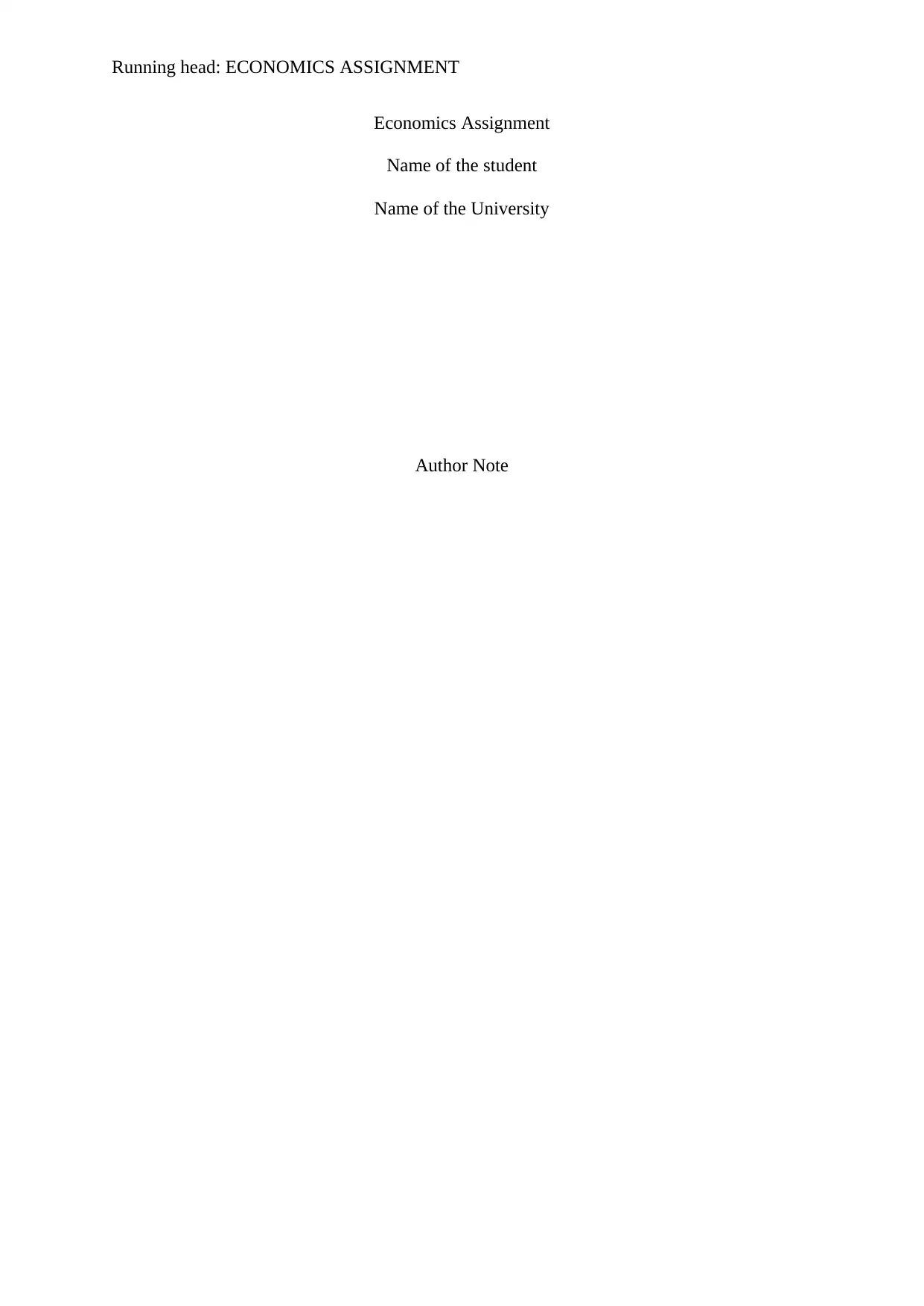
Running head: ECONOMICS ASSIGNMENT
Economics Assignment
Name of the student
Name of the University
Author Note
Economics Assignment
Name of the student
Name of the University
Author Note
Secure Best Marks with AI Grader
Need help grading? Try our AI Grader for instant feedback on your assignments.
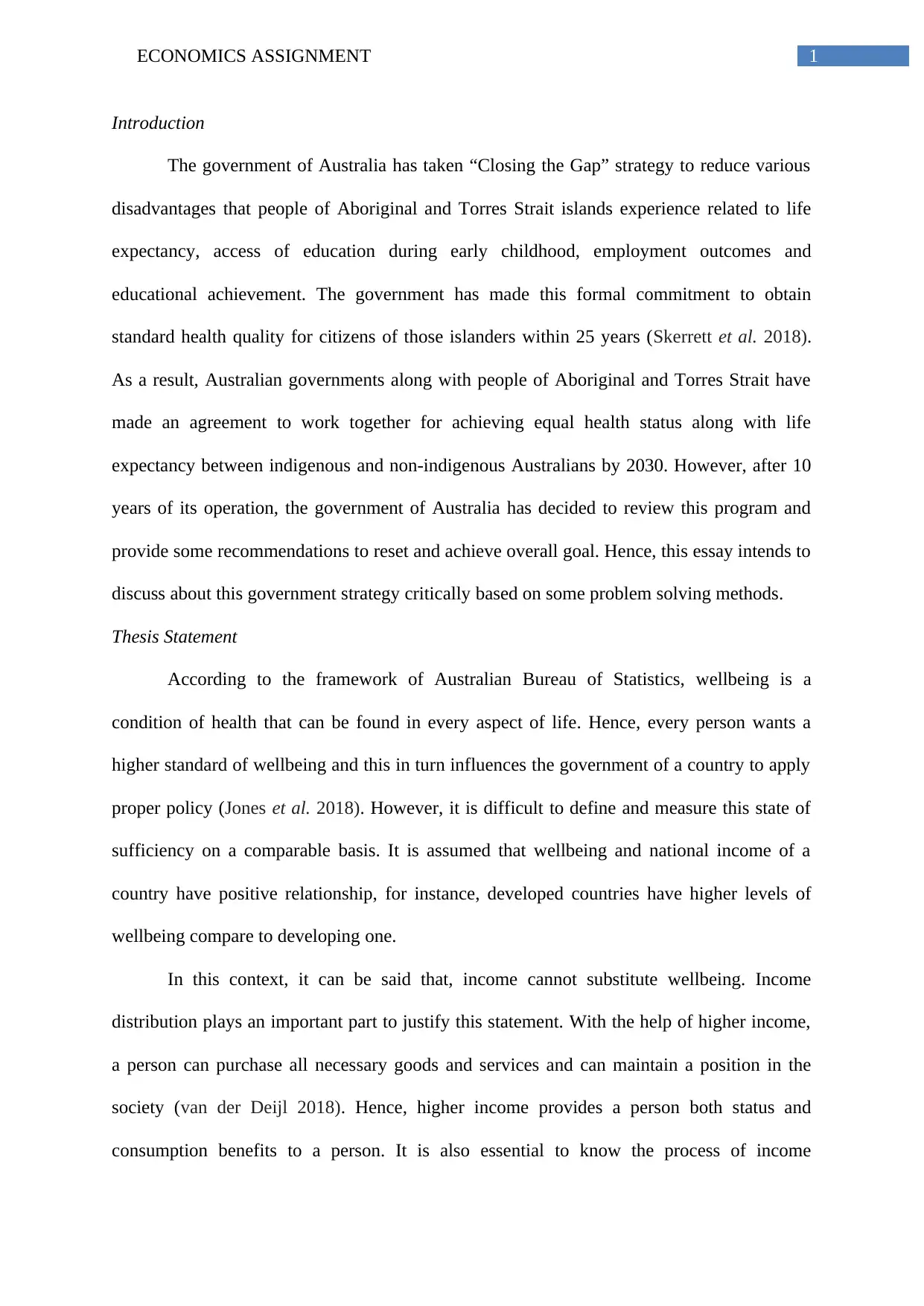
1ECONOMICS ASSIGNMENT
Introduction
The government of Australia has taken “Closing the Gap” strategy to reduce various
disadvantages that people of Aboriginal and Torres Strait islands experience related to life
expectancy, access of education during early childhood, employment outcomes and
educational achievement. The government has made this formal commitment to obtain
standard health quality for citizens of those islanders within 25 years (Skerrett et al. 2018).
As a result, Australian governments along with people of Aboriginal and Torres Strait have
made an agreement to work together for achieving equal health status along with life
expectancy between indigenous and non-indigenous Australians by 2030. However, after 10
years of its operation, the government of Australia has decided to review this program and
provide some recommendations to reset and achieve overall goal. Hence, this essay intends to
discuss about this government strategy critically based on some problem solving methods.
Thesis Statement
According to the framework of Australian Bureau of Statistics, wellbeing is a
condition of health that can be found in every aspect of life. Hence, every person wants a
higher standard of wellbeing and this in turn influences the government of a country to apply
proper policy (Jones et al. 2018). However, it is difficult to define and measure this state of
sufficiency on a comparable basis. It is assumed that wellbeing and national income of a
country have positive relationship, for instance, developed countries have higher levels of
wellbeing compare to developing one.
In this context, it can be said that, income cannot substitute wellbeing. Income
distribution plays an important part to justify this statement. With the help of higher income,
a person can purchase all necessary goods and services and can maintain a position in the
society (van der Deijl 2018). Hence, higher income provides a person both status and
consumption benefits to a person. It is also essential to know the process of income
Introduction
The government of Australia has taken “Closing the Gap” strategy to reduce various
disadvantages that people of Aboriginal and Torres Strait islands experience related to life
expectancy, access of education during early childhood, employment outcomes and
educational achievement. The government has made this formal commitment to obtain
standard health quality for citizens of those islanders within 25 years (Skerrett et al. 2018).
As a result, Australian governments along with people of Aboriginal and Torres Strait have
made an agreement to work together for achieving equal health status along with life
expectancy between indigenous and non-indigenous Australians by 2030. However, after 10
years of its operation, the government of Australia has decided to review this program and
provide some recommendations to reset and achieve overall goal. Hence, this essay intends to
discuss about this government strategy critically based on some problem solving methods.
Thesis Statement
According to the framework of Australian Bureau of Statistics, wellbeing is a
condition of health that can be found in every aspect of life. Hence, every person wants a
higher standard of wellbeing and this in turn influences the government of a country to apply
proper policy (Jones et al. 2018). However, it is difficult to define and measure this state of
sufficiency on a comparable basis. It is assumed that wellbeing and national income of a
country have positive relationship, for instance, developed countries have higher levels of
wellbeing compare to developing one.
In this context, it can be said that, income cannot substitute wellbeing. Income
distribution plays an important part to justify this statement. With the help of higher income,
a person can purchase all necessary goods and services and can maintain a position in the
society (van der Deijl 2018). Hence, higher income provides a person both status and
consumption benefits to a person. It is also essential to know the process of income
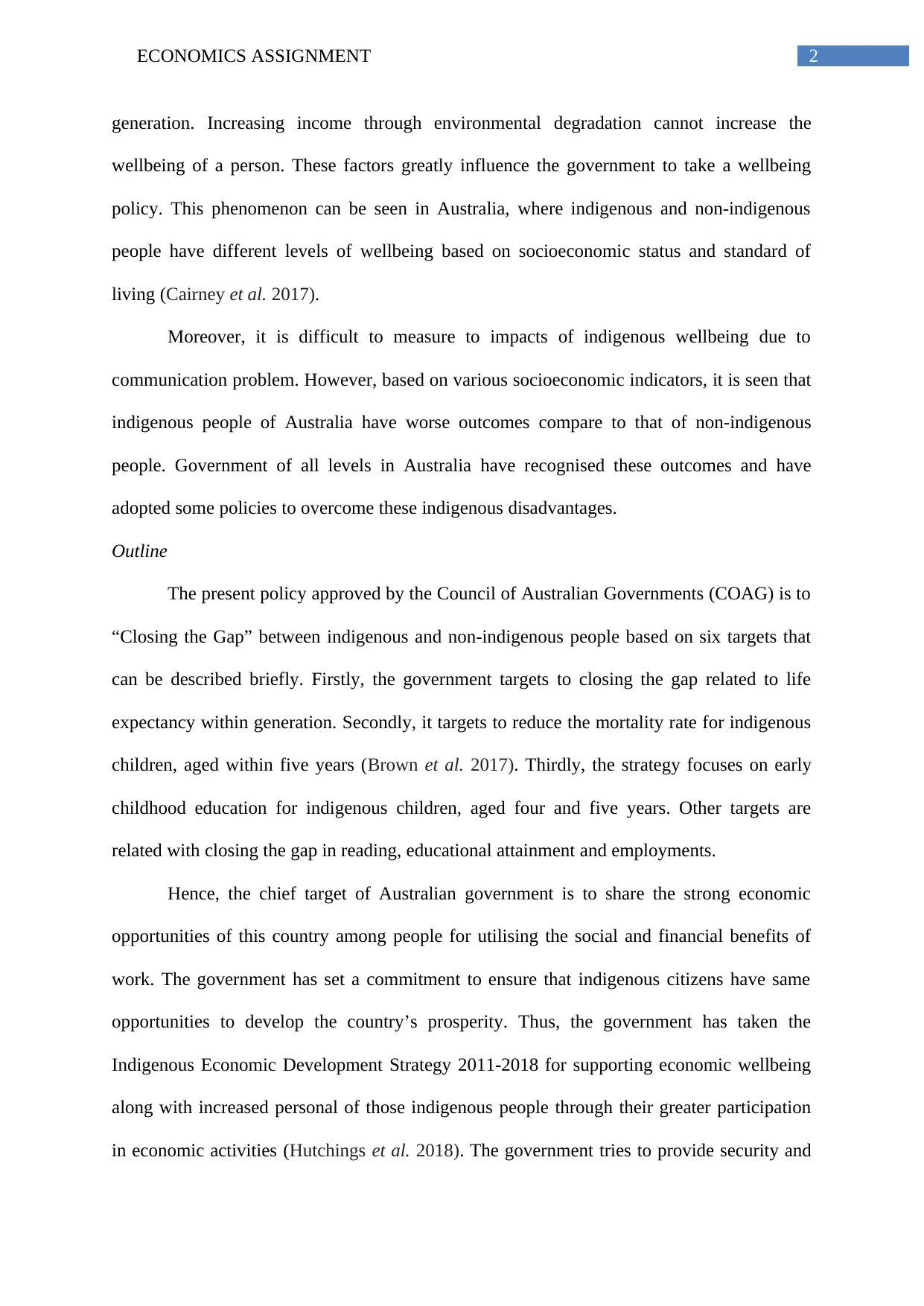
2ECONOMICS ASSIGNMENT
generation. Increasing income through environmental degradation cannot increase the
wellbeing of a person. These factors greatly influence the government to take a wellbeing
policy. This phenomenon can be seen in Australia, where indigenous and non-indigenous
people have different levels of wellbeing based on socioeconomic status and standard of
living (Cairney et al. 2017).
Moreover, it is difficult to measure to impacts of indigenous wellbeing due to
communication problem. However, based on various socioeconomic indicators, it is seen that
indigenous people of Australia have worse outcomes compare to that of non-indigenous
people. Government of all levels in Australia have recognised these outcomes and have
adopted some policies to overcome these indigenous disadvantages.
Outline
The present policy approved by the Council of Australian Governments (COAG) is to
“Closing the Gap” between indigenous and non-indigenous people based on six targets that
can be described briefly. Firstly, the government targets to closing the gap related to life
expectancy within generation. Secondly, it targets to reduce the mortality rate for indigenous
children, aged within five years (Brown et al. 2017). Thirdly, the strategy focuses on early
childhood education for indigenous children, aged four and five years. Other targets are
related with closing the gap in reading, educational attainment and employments.
Hence, the chief target of Australian government is to share the strong economic
opportunities of this country among people for utilising the social and financial benefits of
work. The government has set a commitment to ensure that indigenous citizens have same
opportunities to develop the country’s prosperity. Thus, the government has taken the
Indigenous Economic Development Strategy 2011-2018 for supporting economic wellbeing
along with increased personal of those indigenous people through their greater participation
in economic activities (Hutchings et al. 2018). The government tries to provide security and
generation. Increasing income through environmental degradation cannot increase the
wellbeing of a person. These factors greatly influence the government to take a wellbeing
policy. This phenomenon can be seen in Australia, where indigenous and non-indigenous
people have different levels of wellbeing based on socioeconomic status and standard of
living (Cairney et al. 2017).
Moreover, it is difficult to measure to impacts of indigenous wellbeing due to
communication problem. However, based on various socioeconomic indicators, it is seen that
indigenous people of Australia have worse outcomes compare to that of non-indigenous
people. Government of all levels in Australia have recognised these outcomes and have
adopted some policies to overcome these indigenous disadvantages.
Outline
The present policy approved by the Council of Australian Governments (COAG) is to
“Closing the Gap” between indigenous and non-indigenous people based on six targets that
can be described briefly. Firstly, the government targets to closing the gap related to life
expectancy within generation. Secondly, it targets to reduce the mortality rate for indigenous
children, aged within five years (Brown et al. 2017). Thirdly, the strategy focuses on early
childhood education for indigenous children, aged four and five years. Other targets are
related with closing the gap in reading, educational attainment and employments.
Hence, the chief target of Australian government is to share the strong economic
opportunities of this country among people for utilising the social and financial benefits of
work. The government has set a commitment to ensure that indigenous citizens have same
opportunities to develop the country’s prosperity. Thus, the government has taken the
Indigenous Economic Development Strategy 2011-2018 for supporting economic wellbeing
along with increased personal of those indigenous people through their greater participation
in economic activities (Hutchings et al. 2018). The government tries to provide security and
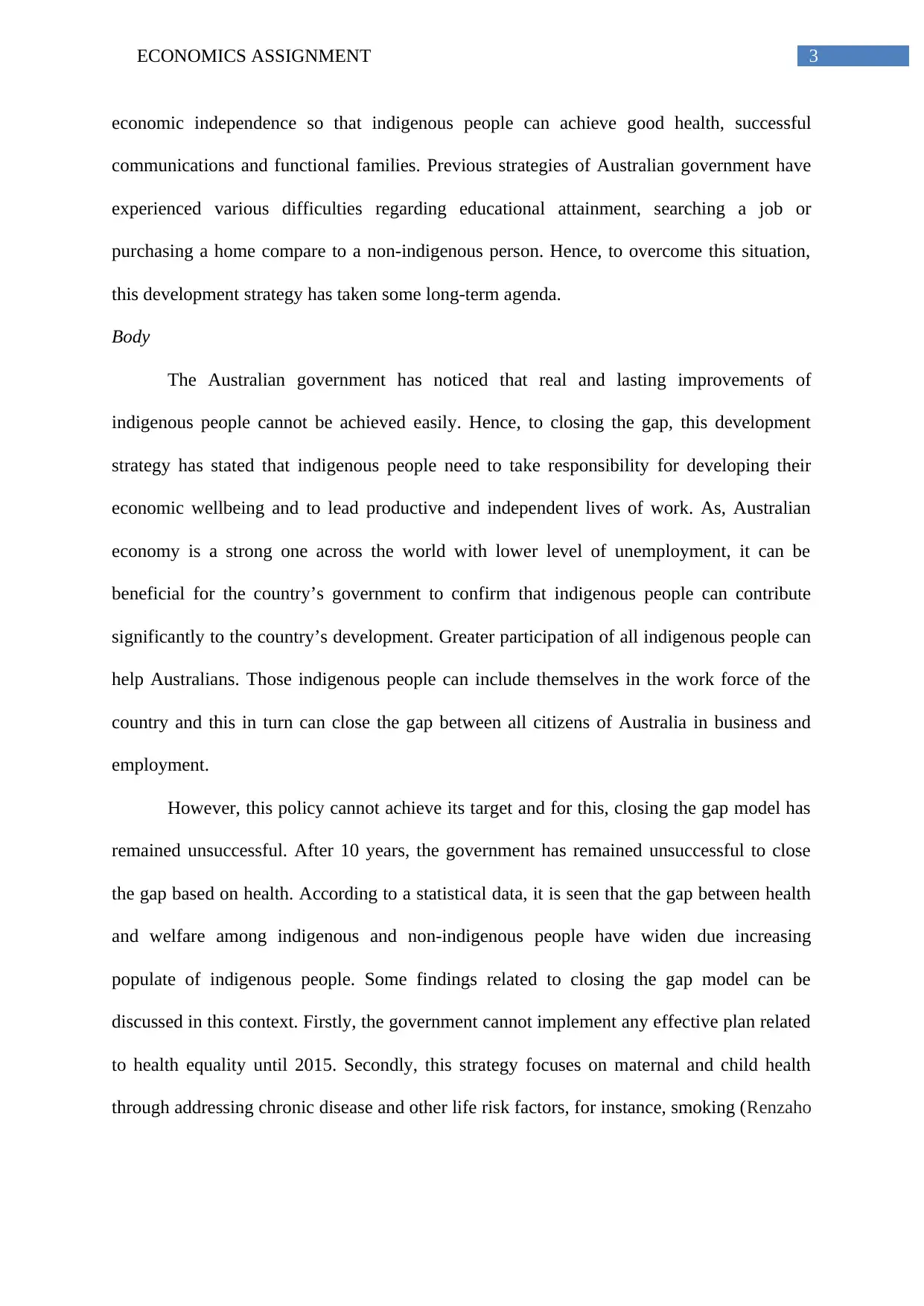
3ECONOMICS ASSIGNMENT
economic independence so that indigenous people can achieve good health, successful
communications and functional families. Previous strategies of Australian government have
experienced various difficulties regarding educational attainment, searching a job or
purchasing a home compare to a non-indigenous person. Hence, to overcome this situation,
this development strategy has taken some long-term agenda.
Body
The Australian government has noticed that real and lasting improvements of
indigenous people cannot be achieved easily. Hence, to closing the gap, this development
strategy has stated that indigenous people need to take responsibility for developing their
economic wellbeing and to lead productive and independent lives of work. As, Australian
economy is a strong one across the world with lower level of unemployment, it can be
beneficial for the country’s government to confirm that indigenous people can contribute
significantly to the country’s development. Greater participation of all indigenous people can
help Australians. Those indigenous people can include themselves in the work force of the
country and this in turn can close the gap between all citizens of Australia in business and
employment.
However, this policy cannot achieve its target and for this, closing the gap model has
remained unsuccessful. After 10 years, the government has remained unsuccessful to close
the gap based on health. According to a statistical data, it is seen that the gap between health
and welfare among indigenous and non-indigenous people have widen due increasing
populate of indigenous people. Some findings related to closing the gap model can be
discussed in this context. Firstly, the government cannot implement any effective plan related
to health equality until 2015. Secondly, this strategy focuses on maternal and child health
through addressing chronic disease and other life risk factors, for instance, smoking (Renzaho
economic independence so that indigenous people can achieve good health, successful
communications and functional families. Previous strategies of Australian government have
experienced various difficulties regarding educational attainment, searching a job or
purchasing a home compare to a non-indigenous person. Hence, to overcome this situation,
this development strategy has taken some long-term agenda.
Body
The Australian government has noticed that real and lasting improvements of
indigenous people cannot be achieved easily. Hence, to closing the gap, this development
strategy has stated that indigenous people need to take responsibility for developing their
economic wellbeing and to lead productive and independent lives of work. As, Australian
economy is a strong one across the world with lower level of unemployment, it can be
beneficial for the country’s government to confirm that indigenous people can contribute
significantly to the country’s development. Greater participation of all indigenous people can
help Australians. Those indigenous people can include themselves in the work force of the
country and this in turn can close the gap between all citizens of Australia in business and
employment.
However, this policy cannot achieve its target and for this, closing the gap model has
remained unsuccessful. After 10 years, the government has remained unsuccessful to close
the gap based on health. According to a statistical data, it is seen that the gap between health
and welfare among indigenous and non-indigenous people have widen due increasing
populate of indigenous people. Some findings related to closing the gap model can be
discussed in this context. Firstly, the government cannot implement any effective plan related
to health equality until 2015. Secondly, this strategy focuses on maternal and child health
through addressing chronic disease and other life risk factors, for instance, smoking (Renzaho
Secure Best Marks with AI Grader
Need help grading? Try our AI Grader for instant feedback on your assignments.
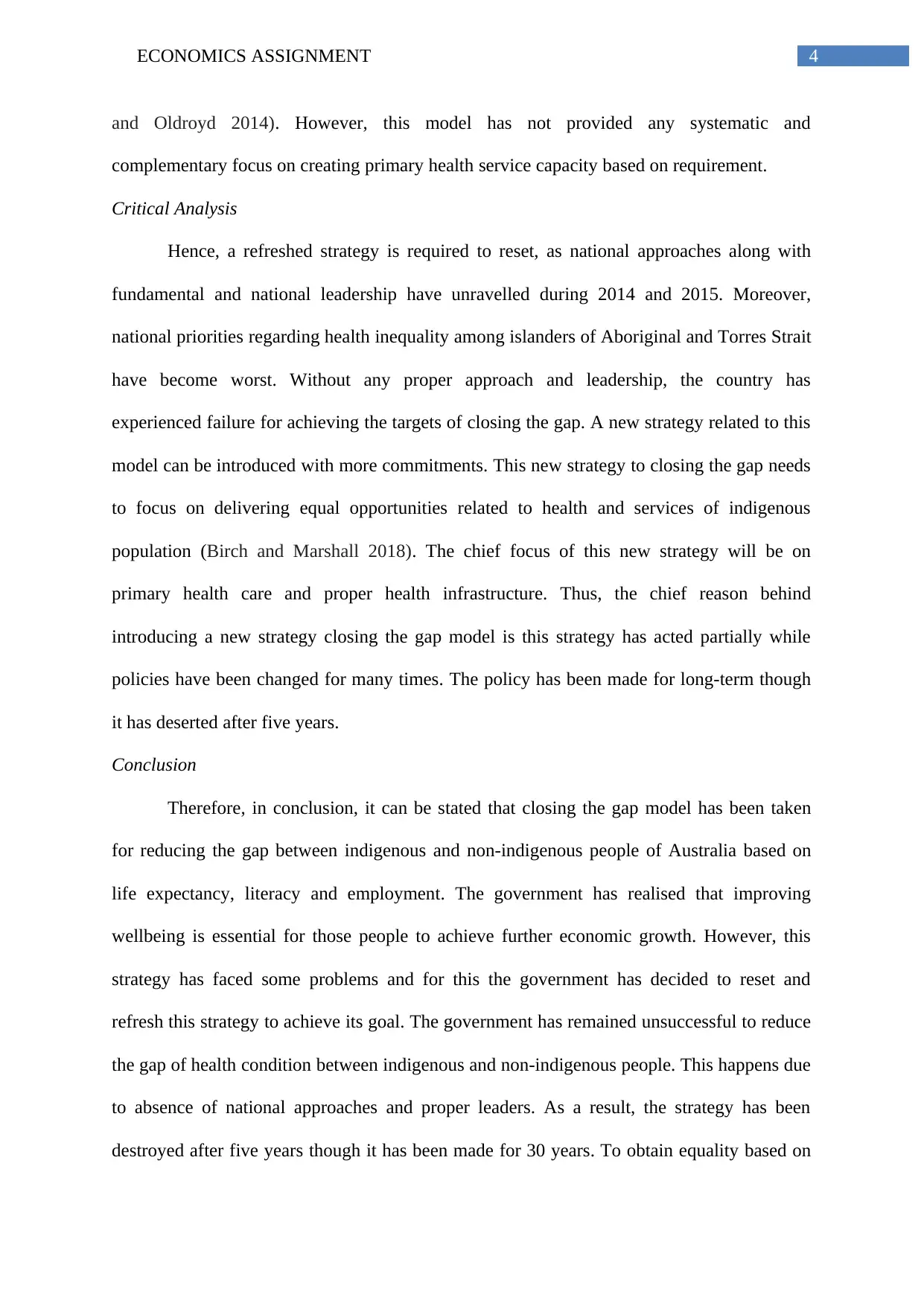
4ECONOMICS ASSIGNMENT
and Oldroyd 2014). However, this model has not provided any systematic and
complementary focus on creating primary health service capacity based on requirement.
Critical Analysis
Hence, a refreshed strategy is required to reset, as national approaches along with
fundamental and national leadership have unravelled during 2014 and 2015. Moreover,
national priorities regarding health inequality among islanders of Aboriginal and Torres Strait
have become worst. Without any proper approach and leadership, the country has
experienced failure for achieving the targets of closing the gap. A new strategy related to this
model can be introduced with more commitments. This new strategy to closing the gap needs
to focus on delivering equal opportunities related to health and services of indigenous
population (Birch and Marshall 2018). The chief focus of this new strategy will be on
primary health care and proper health infrastructure. Thus, the chief reason behind
introducing a new strategy closing the gap model is this strategy has acted partially while
policies have been changed for many times. The policy has been made for long-term though
it has deserted after five years.
Conclusion
Therefore, in conclusion, it can be stated that closing the gap model has been taken
for reducing the gap between indigenous and non-indigenous people of Australia based on
life expectancy, literacy and employment. The government has realised that improving
wellbeing is essential for those people to achieve further economic growth. However, this
strategy has faced some problems and for this the government has decided to reset and
refresh this strategy to achieve its goal. The government has remained unsuccessful to reduce
the gap of health condition between indigenous and non-indigenous people. This happens due
to absence of national approaches and proper leaders. As a result, the strategy has been
destroyed after five years though it has been made for 30 years. To obtain equality based on
and Oldroyd 2014). However, this model has not provided any systematic and
complementary focus on creating primary health service capacity based on requirement.
Critical Analysis
Hence, a refreshed strategy is required to reset, as national approaches along with
fundamental and national leadership have unravelled during 2014 and 2015. Moreover,
national priorities regarding health inequality among islanders of Aboriginal and Torres Strait
have become worst. Without any proper approach and leadership, the country has
experienced failure for achieving the targets of closing the gap. A new strategy related to this
model can be introduced with more commitments. This new strategy to closing the gap needs
to focus on delivering equal opportunities related to health and services of indigenous
population (Birch and Marshall 2018). The chief focus of this new strategy will be on
primary health care and proper health infrastructure. Thus, the chief reason behind
introducing a new strategy closing the gap model is this strategy has acted partially while
policies have been changed for many times. The policy has been made for long-term though
it has deserted after five years.
Conclusion
Therefore, in conclusion, it can be stated that closing the gap model has been taken
for reducing the gap between indigenous and non-indigenous people of Australia based on
life expectancy, literacy and employment. The government has realised that improving
wellbeing is essential for those people to achieve further economic growth. However, this
strategy has faced some problems and for this the government has decided to reset and
refresh this strategy to achieve its goal. The government has remained unsuccessful to reduce
the gap of health condition between indigenous and non-indigenous people. This happens due
to absence of national approaches and proper leaders. As a result, the strategy has been
destroyed after five years though it has been made for 30 years. To obtain equality based on
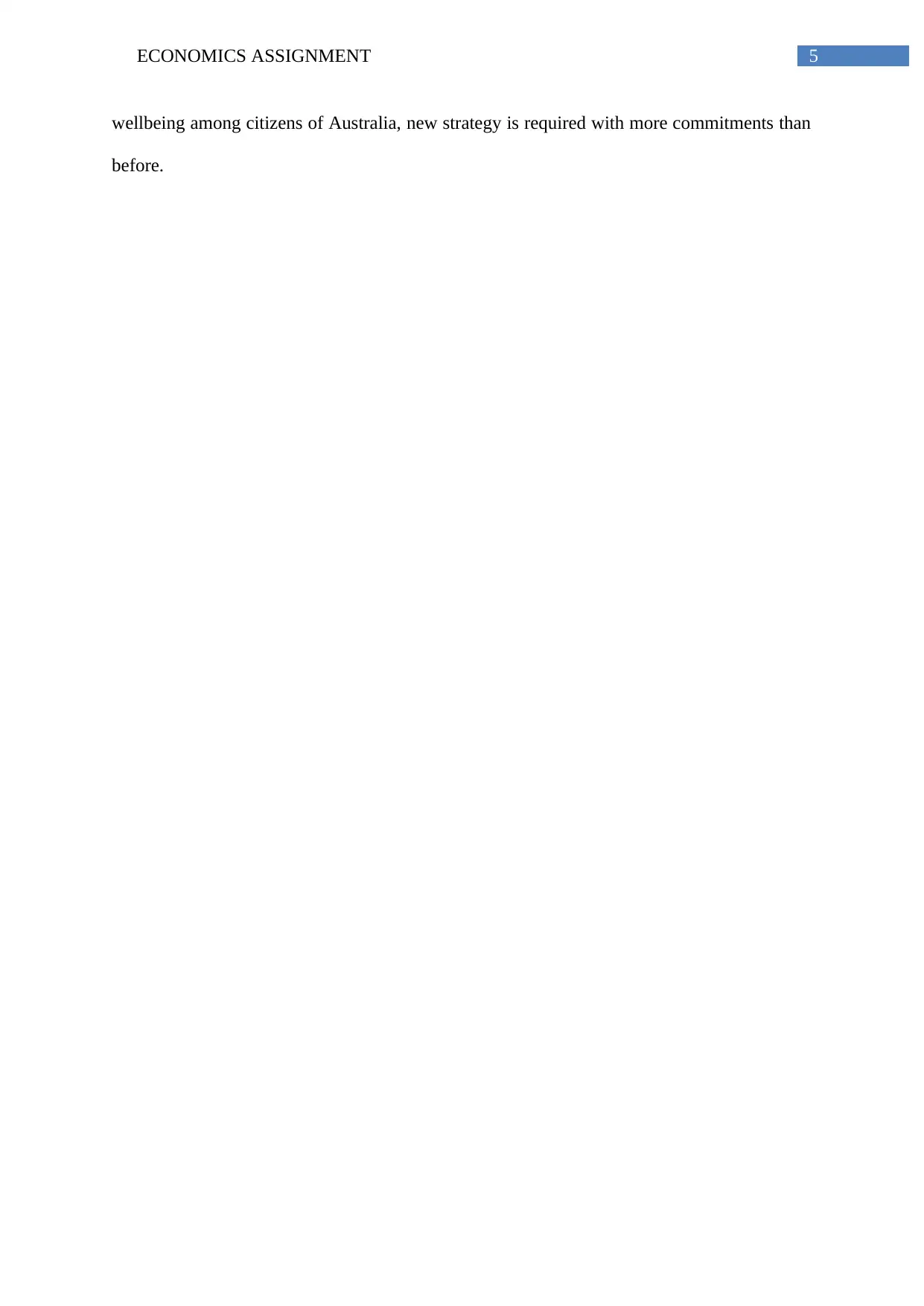
5ECONOMICS ASSIGNMENT
wellbeing among citizens of Australia, new strategy is required with more commitments than
before.
wellbeing among citizens of Australia, new strategy is required with more commitments than
before.
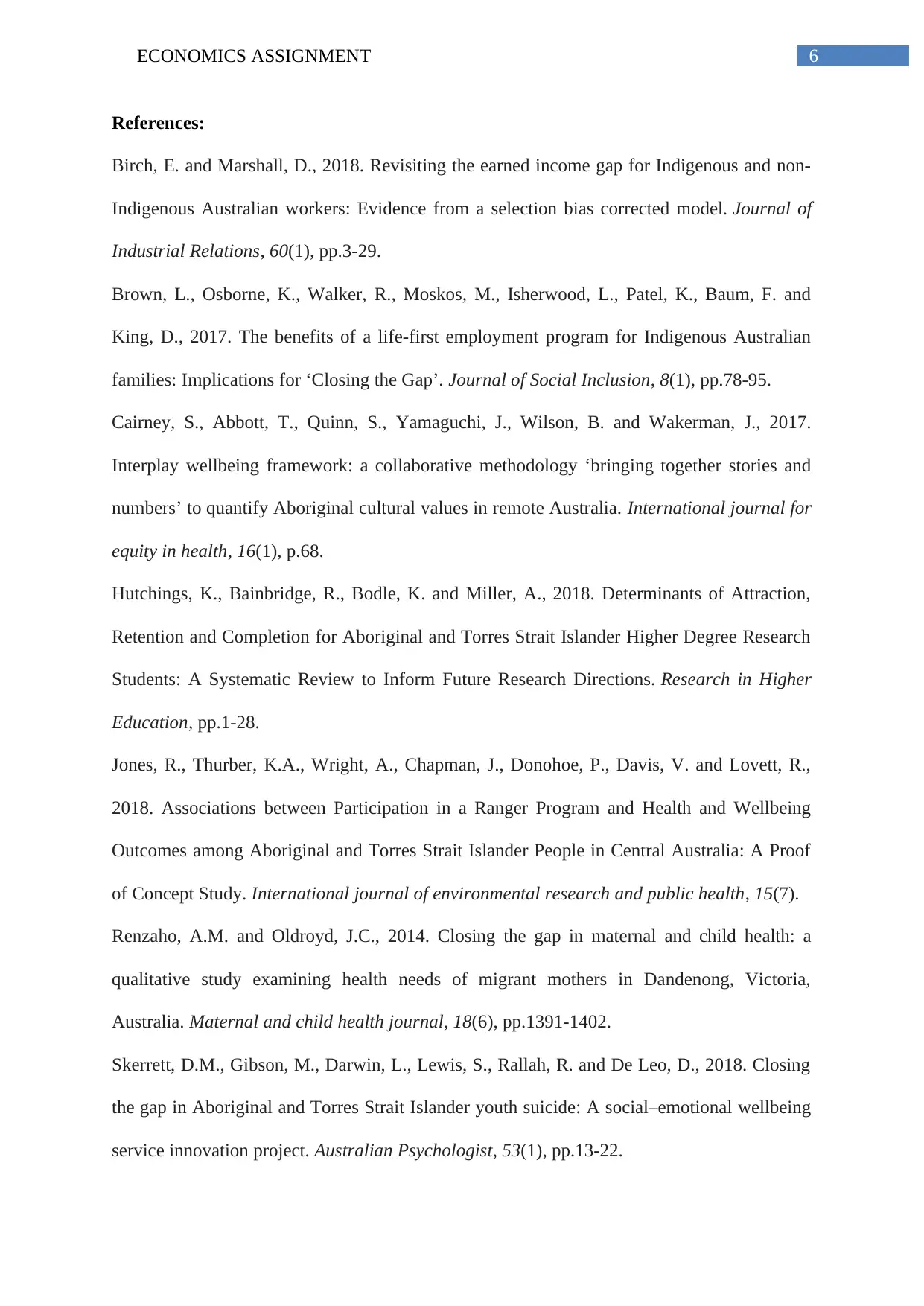
6ECONOMICS ASSIGNMENT
References:
Birch, E. and Marshall, D., 2018. Revisiting the earned income gap for Indigenous and non-
Indigenous Australian workers: Evidence from a selection bias corrected model. Journal of
Industrial Relations, 60(1), pp.3-29.
Brown, L., Osborne, K., Walker, R., Moskos, M., Isherwood, L., Patel, K., Baum, F. and
King, D., 2017. The benefits of a life-first employment program for Indigenous Australian
families: Implications for ‘Closing the Gap’. Journal of Social Inclusion, 8(1), pp.78-95.
Cairney, S., Abbott, T., Quinn, S., Yamaguchi, J., Wilson, B. and Wakerman, J., 2017.
Interplay wellbeing framework: a collaborative methodology ‘bringing together stories and
numbers’ to quantify Aboriginal cultural values in remote Australia. International journal for
equity in health, 16(1), p.68.
Hutchings, K., Bainbridge, R., Bodle, K. and Miller, A., 2018. Determinants of Attraction,
Retention and Completion for Aboriginal and Torres Strait Islander Higher Degree Research
Students: A Systematic Review to Inform Future Research Directions. Research in Higher
Education, pp.1-28.
Jones, R., Thurber, K.A., Wright, A., Chapman, J., Donohoe, P., Davis, V. and Lovett, R.,
2018. Associations between Participation in a Ranger Program and Health and Wellbeing
Outcomes among Aboriginal and Torres Strait Islander People in Central Australia: A Proof
of Concept Study. International journal of environmental research and public health, 15(7).
Renzaho, A.M. and Oldroyd, J.C., 2014. Closing the gap in maternal and child health: a
qualitative study examining health needs of migrant mothers in Dandenong, Victoria,
Australia. Maternal and child health journal, 18(6), pp.1391-1402.
Skerrett, D.M., Gibson, M., Darwin, L., Lewis, S., Rallah, R. and De Leo, D., 2018. Closing
the gap in Aboriginal and Torres Strait Islander youth suicide: A social–emotional wellbeing
service innovation project. Australian Psychologist, 53(1), pp.13-22.
References:
Birch, E. and Marshall, D., 2018. Revisiting the earned income gap for Indigenous and non-
Indigenous Australian workers: Evidence from a selection bias corrected model. Journal of
Industrial Relations, 60(1), pp.3-29.
Brown, L., Osborne, K., Walker, R., Moskos, M., Isherwood, L., Patel, K., Baum, F. and
King, D., 2017. The benefits of a life-first employment program for Indigenous Australian
families: Implications for ‘Closing the Gap’. Journal of Social Inclusion, 8(1), pp.78-95.
Cairney, S., Abbott, T., Quinn, S., Yamaguchi, J., Wilson, B. and Wakerman, J., 2017.
Interplay wellbeing framework: a collaborative methodology ‘bringing together stories and
numbers’ to quantify Aboriginal cultural values in remote Australia. International journal for
equity in health, 16(1), p.68.
Hutchings, K., Bainbridge, R., Bodle, K. and Miller, A., 2018. Determinants of Attraction,
Retention and Completion for Aboriginal and Torres Strait Islander Higher Degree Research
Students: A Systematic Review to Inform Future Research Directions. Research in Higher
Education, pp.1-28.
Jones, R., Thurber, K.A., Wright, A., Chapman, J., Donohoe, P., Davis, V. and Lovett, R.,
2018. Associations between Participation in a Ranger Program and Health and Wellbeing
Outcomes among Aboriginal and Torres Strait Islander People in Central Australia: A Proof
of Concept Study. International journal of environmental research and public health, 15(7).
Renzaho, A.M. and Oldroyd, J.C., 2014. Closing the gap in maternal and child health: a
qualitative study examining health needs of migrant mothers in Dandenong, Victoria,
Australia. Maternal and child health journal, 18(6), pp.1391-1402.
Skerrett, D.M., Gibson, M., Darwin, L., Lewis, S., Rallah, R. and De Leo, D., 2018. Closing
the gap in Aboriginal and Torres Strait Islander youth suicide: A social–emotional wellbeing
service innovation project. Australian Psychologist, 53(1), pp.13-22.
Paraphrase This Document
Need a fresh take? Get an instant paraphrase of this document with our AI Paraphraser
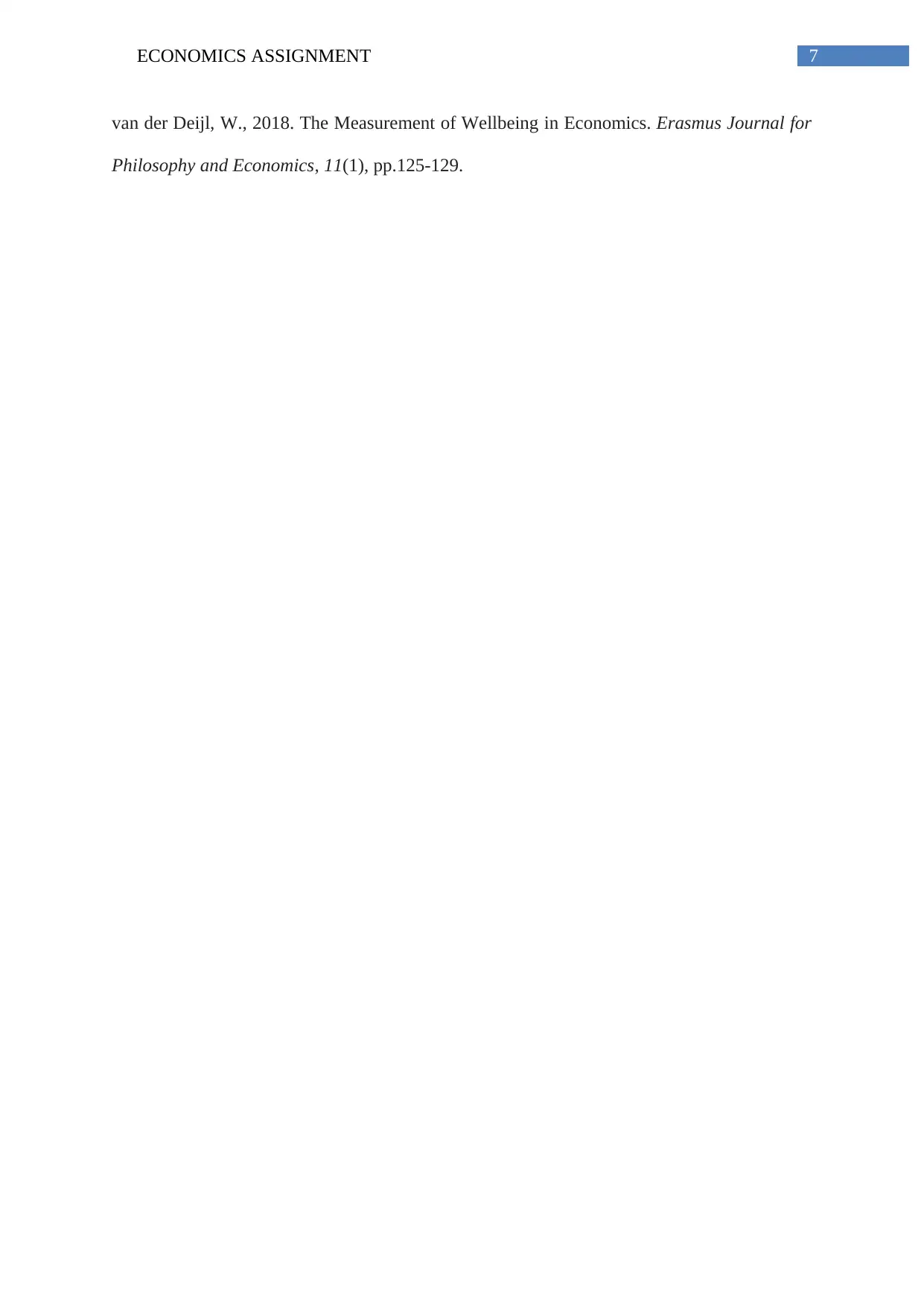
7ECONOMICS ASSIGNMENT
van der Deijl, W., 2018. The Measurement of Wellbeing in Economics. Erasmus Journal for
Philosophy and Economics, 11(1), pp.125-129.
van der Deijl, W., 2018. The Measurement of Wellbeing in Economics. Erasmus Journal for
Philosophy and Economics, 11(1), pp.125-129.
1 out of 8
Related Documents
Your All-in-One AI-Powered Toolkit for Academic Success.
+13062052269
info@desklib.com
Available 24*7 on WhatsApp / Email
![[object Object]](/_next/static/media/star-bottom.7253800d.svg)
Unlock your academic potential
© 2024 | Zucol Services PVT LTD | All rights reserved.





